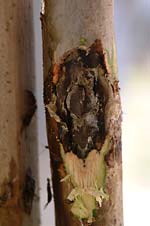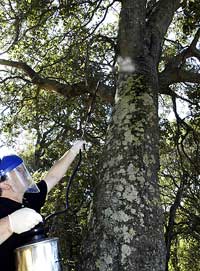New treatment for Sudden Oak Death approved based upon research by UC Berkeley plant pathologist
| Frequently Asked Questions about the Sudden Oak Death treatment |
The Department of Pesticide Regulation approved a special registration for this treatment on a fast-tracked, special needs basis. It is the first and only treatment approved by the state for use against a pathogen that has killed tens of thousands of coastal oak trees from California's Big Sur to the border of Oregon.
  At left, an untreated oak sapling 8 weeks after being infected with the Sudden Oak Death pathogen. At right, an oak sapling treated with Agri-Fos and then inoculated 7 days later with the Sudden Oak Death pathogen. After 8 weeks, the inoculation wound is still present, but the treatment has prevented the pathogen from growing. (Photos courtesy of Matteo Garbelotto) |
"The likely areas where the treatment would be used include mostly private-owned land, but trees around high-use facilities in public parks may also be potential candidates," said the UC Berkeley researcher, Matteo Garbelotto, who is an adjunct assistant professor of ecosystem sciences and cooperative extension specialist at UC Berkeley's College of Natural Resources. "It's really meant for individual oaks or tanoaks that are at high risk for infection, such as those in the vicinity of infected California bay laurel trees."
Garbelotto explained that in the wild, California bay laurel trees are considered the most important vector for spreading Sudden Oak Death. Spores congregate on the leaves of those trees, where they can easily become airborne.
Garbelotto and David Rizzo, associate professor of plant pathology at UC Davis, first identified Phytophthora ramorum three years ago as the fungus-like pathogen responsible for Sudden Oak Death. Since the disease was first observed in Marin County in 1994, it has spread to 12 California counties, including Alameda and Contra Costa counties, and it has been confirmed in at least 25 different plant species, including California bay laurels and rhododendrons. It has also been found in nurseries in Washington state and British Columbia, Canada.
"It hasn't been long since the pathogen was first isolated," said Garbelotto, who presented results of his research at a recent meeting of the American Phytopathological Society. "The development of a treatment has been incredibly rapid."
The approved treatment is a phosphite compound sold under the brand name Agri-Fos, and its effectiveness has been proven for oaks and tanoaks. Agri-Fos is a fungicide that has been effective for other Phytophthora species, but Garbelotto was the first to test it on P. ramorum. Agrichem, the Australian based company that sells Agri-Fos, will make the treatment available to trained professionals licensed by the state to apply pesticides.
Garbelotto emphasized that the treatment is not a cure-all, and said there is no evidence to show that it would be recommended on a widespread basis. The treatment has not been tested on other plant and tree species susceptible to Sudden Oak Death.
The confirmation last year that redwood and Douglas fir - two of the state's most highly prized trees - were susceptible to the pathogen sparked concerns of the pathogen's ability to do more damage. But it is the state's oak trees that have suffered the pathogen's most dramatic impact, exhibiting oozing lesions and cankers as they die.
Garbelotto has conducted more than 30 independent trials of treatment protocols. Steven Tjosvold, a cooperative extension specialist with Santa Cruz County, helped Garbelotto with field experiments.
To test whether the treatment worked on diseased trees, Garbelotto infected potted oaks and tanoaks with P. ramorum and then waited several days to several weeks before injecting the phosphite compound. The injections slowed down the growth of cankers on trees that were treated.
Not surprisingly, he found that the effectiveness of the treatment declines steadily the longer the tree has been infected. "Ideally, this would be used as soon as symptoms are noted," said Garbelotto. "The treatment is not recommended if the symptoms have been around for a year or more."
He noted that the treatment does not kill the pathogen, but that it stops its growth if used in the early stages of infection.
He also found that injecting oaks and tanoaks with the chemical first and then inoculating them with the pathogen effectively prevented infection. When used as a preventative agent, the treatment completely protected smaller trees, and it reduced the canker size by half on adult trees.
 A UC Berkeley research assistant sprays an adult oak tree with a newly registered treatment to prevent Sudden Oak Death infection. |
Through his experiments, Garbelotto also developed an innovative way of increasing the effectiveness of the phosphite compound by combining it with an organosilicate carrier, named Pentra-Bark, that helps trees gradually absorb the treatment over time. Instead of injecting the compound, Garbelotto sprayed it directly onto the bark of the trees.
"This method of delivering the treatment to the tree is completely new," said Garbelotto. "It's a discovery that can revolutionize the way trees are treated."
The organosilicate used in this treatment had not been proven successful in carrying chemicals through the bark until Garbelotto paired it with the phosphite compound. The matching works well because the molecular structure of the phosphite is compatible with that of the organosilicate, he said.
"By combining the phosphite compound with organosilicate, the treatment can be sprayed onto the bark instead of injected," said Garbelotto. "The application is so easy compared to injection, which is complicated and requires a lot of skill to do right. With injection, it is hard to know if you are getting the compound into the tree's vascular system, so if you don't know what you're doing, a lot of the compound can get lost."
In addition, applying the treatment to the bark makes the treatment available to the tree for more than six months. "Once applied, it doesn't rub off," said Garbelotto. "It's comparable to a time-release drug patch for humans."
Based upon existing research, the treatment is recommended once a year, said Garbelotto.
However, the topical application has thus far only been shown effective in oak trees. The compound has not been successfully absorbed through the bark of tanoak trees.
Garbelotto noted that phosphites have been used for more than 10 years and are considered a low-toxicity chemical. In addition, the methods of application - both injection and bark spray - are targeted so that the chemical is not dispersed into surrounding areas.
Nevertheless, he emphasized the need for training before the treatment is used for Sudden Oak Death. Training sessions for professional arborists will be offered through UC Cooperative Extension on Monday, Oct. 20, in Marin County, and Tuesday, Oct. 21, in Santa Cruz County. Details on the classes will be available online within the next week at http://www.suddenoakdeath.org.
"Until now, many oak trees in northern California faced a potential death sentence from Sudden Oak Death," said Assemblywoman Patricia Wiggins (D-Santa Rosa), who was instrumental in expediting the approval of the phosphite-based treatment. "Dr. Garbelotto and his associates moved quickly, professionally and with great care to find a treatment, for which we are very grateful."
Garbelotto's
research was supported by the Gordon and Betty Moore Foundation
and the USDA Forest Service Pacific Southwest Region. The Valley Crest
Tree Company provided hundreds of potted trees used for the
research,
and Lucasfilm, Ltd., granted access to company
property for this research.

